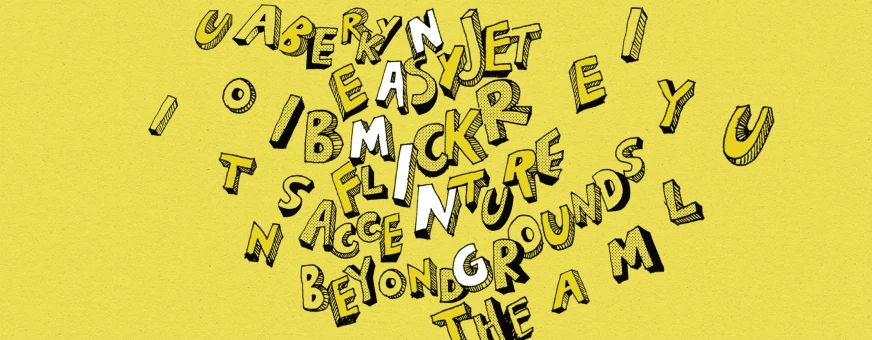Brand
4 minutes read
Sparks Team

We get asked to help name or rename brands all the time. Sometimes it’s a startup launching into a crowded space. Other times it’s a merger, a shift in strategy, or needing to grow beyond a name that no longer fits. And yes, sometimes a crisis forces change.
So when people come to us asking, How do we choose the right name?, it isn't a silly question. In a world where “anything goes,” how can you be sure you landed on something good?
Naming is one of the most exciting parts of brand-building. But it’s not easy. A great name creates momentum. The wrong one can become expensive baggage.
Just ask Aberdeen. Their 2021 rebrand from Standard Life Aberdeen to “ABRDN” made headlines — and in 2024 they changed to Aberdeen Group. Chief executive Jason Windsor said the name change would remove "distractions".
What to remember when naming
Some things are still true, no matter what’s trending:
No name does everything. It’s just a word until you fill it with meaning. The job of a name is to hold space for that meaning, not to explain everything at once. It helps if it’s flexible enough to grow as your business evolves (unlike, say, Carphone Warehouse).
It has to fit into a system. A name works best when it aligns with your strategy, identity, and voice. If it clashes with the rest of the brand, it will always feel a bit off.
Don’t fall in love too early. The name you love might be taken, or it might fall flat when said out loud. At early stages, keep your head and explore widely.
It needs to stick. Bold, distinctive, and easy to say is a winning combination. It can surprise people but shouldn’t feel out of place in your space. And yes, always check what it means in other languages.
Three common naming routes
Most names fall into one of these:
Descriptive – Straightforward and clear (British Airways, Just Eat)
Suggestive – Hint at a feeling, benefit, or positioning (EasyJet, TalkTalk)
Abstract or invented – Unique, open to interpretation (Wii, Accenture, Zara)
The right route depends on your ambitions, competitors, and context. Descriptive names can be clear but limiting. Abstract ones often raise eyebrows at launch but give you space to grow.
A quick word on initials: they’re usually a bad starting point unless your brand is already well known. IBM can get away with it. Most new businesses can’t. Abbreviations tend to be forgettable, hard to say, and meaningless without backstory.
That said, some acronyms do work when they’re simple, easy to say, and carry intentional meaning. IKEA is a great example (a blend of the founder’s name, farm, and village). Sprint, the telecoms company, benefits from a name that also signals speed.
Don’t pick a name that makes you one of the trees in the forest, and then spend the rest of your marketing budget trying to stand out.
Danny Altman, Founder, A Hundred Monkeys
Staying objective
The hardest part of naming is emotional. Everyone has an opinion, and names are deeply subjective. That’s why we always start by helping clients get clear on brand positioning:
- Who are you for?
- What do you want to be known for?
- What do you want people to experience when they work with you?
Once you’ve nailed the strategy, it’s much easier to judge whether a name is right, not just whether it sounds nice.
Take Aberkyn, a leadership consultancy we worked with. The firm was co-founded by ex-McKinsey partners and needed a name that felt powerful, not fluffy. They were helping organisations transform culture, create momentum, and lead change. We explored metaphors of movement and flow and landed on Aberkyn, a name combining “aber” (where rivers meet) and “kyn” (a nod to community and kinship). It gave them a platform to shape a whole brand world.
Another favourite: Beyond The Grounds, a café near Tonbridge Castle. The founder had a vision rooted in community and history. The name played on coffee, heritage, and long-term investment. Simple, distinctive, and loaded with meaning.
Tips that still hold up
Take your time. Don’t rush to shortlist. A name that feels awkward at first might click after a week of hearing it.
Say it out loud. Can you picture your team saying it on the phone? Would a customer remember it?
Test it in real contexts. Mock up a website banner. Write a job ad. See how it feels on screen.
Check availability. Always run domain and trademark checks. A brilliant name you can’t protect isn’t worth much.
Some of the best names felt weird at first. Diageo, Monzo, Accenture all launched to a fair bit of side-eye. But they became household names. Because meaning builds. Stories spread. Consistency wins.
And sometimes? The magic just happens.
In 1997, Pierre Omidyar’s site was called AuctionWeb. He wanted EchoBay.com to tie in with his company’s name, Echo Bay Technology Group. But the domain was taken by a mining company. So he went with plan B: eBay.
P.S. Our name?
We took inspiration from a quote by Calvin Seerveld that’s stayed with us for years:
“Fire your art until it emits sparks that warm, or burn, those it reaches.”
That’s still the aim. To help brands ignite something meaningful and make it stick.

